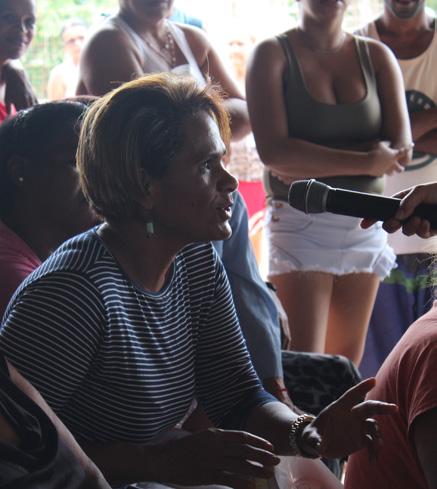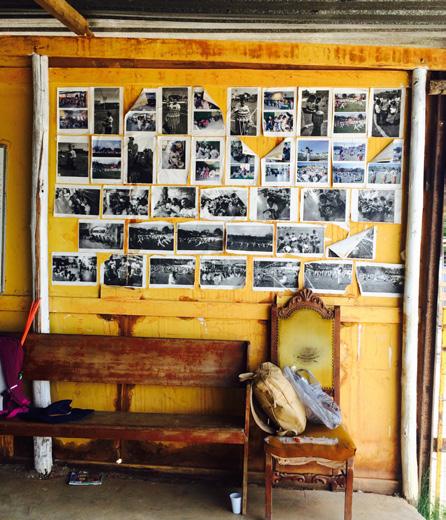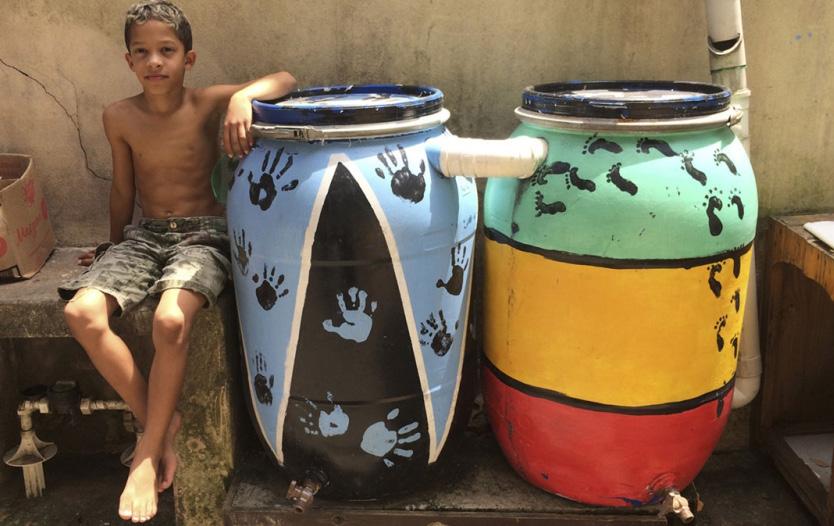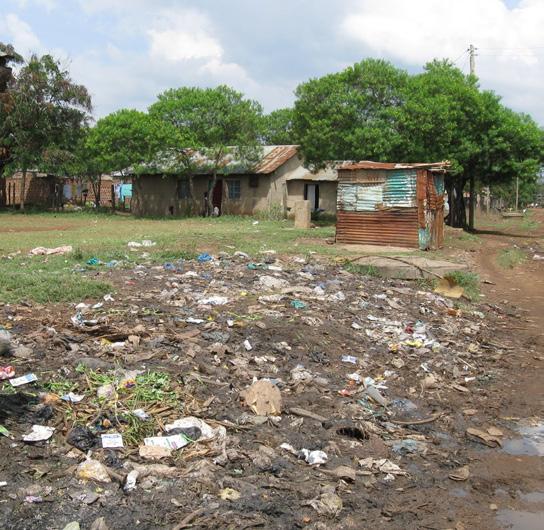
7 minute read
Environmental Education
158 Rain Barrels Timeline.
ENVIRONMENTAL EDUCATION
Environmental education is crucial in ensuring that the waste management action plan succeeds. The survey results suggest that residents have a basis for understanding the importance of solid waste management. Nobody claimed that they burn, bury, or throw their solid waste into streets, waterways, or sewage systems according to the Taubman Team survey results. Virtually all survey respondents reported that they take their trash out to the collective dumpster. Survey results are inconsistent with direct observation findings. The discrepancy in findings may suggest that individuals know that waste should be disposed of properly and feel embarrassed to respond honestly since their behavior does not reflect their notions of what is correct. Environmental educational programming is an additional way to support the other waste management interventions and help promote and sustain a culture around environmental stewardship in Ocupação Anchieta.
The purpose of the educational component is, ultimately, to change behavior. Behavior is changed when personal, internal contentment results from engaging in a new behavior (De Young, 2000). The type of educational programming recommended involves face-toface interaction. Although signage, and other forms of one-way communication, play a role in raising awareness around solid waste issues, a more personal form of education is more impactful because justifications for littering can be explored, criticized and discussed in further depth with greater specificity. Nonetheless, these two forms of communication support one another (Hansmann and Steimer, 2015). Additionally, through educational programming, residents may be able to
understand how environmental quality and solid waste management personally affects their life and their family’s lives. To reinforce an environmentally-conscious culture, education efforts will take multiple forms and include a number of ongoing activities that require resident participation.
Therefore, residents, of all ages and genders, must be interested and willing to participate in environmental education activities for this intervention to be successful. In terms of implementation, both IAG and the Association should be held responsible for facilitating educational activities in the Occupation. The Institute already has educational programming for the children who attend their after school programs, so adding environmental programming to their services is plausible. The Association has a desire to incorporate environmental education into their work because they understand the improvement of environmental conditions to be essential for housing security. The Association also holds monthly community meetings, parties for children, and celebrations on major holidays.
The Association uses WhatsApp to notify residents of events and meetings around the Occupation. The Taubman Team recommends that the Association also uses WhatsApp for notifying residents of the environmental educational activities listed below. The Association’s capacity to organize and communicate coupled with the Institute’s current involvement in youth educational programs illustrates the great potential to expand upon these services environmentally.
The following list includes viable, interactive opportunities for environmental education services in Ocupação Anchieta:

159. Ocupação Anchieta Resident Participates in the March 5th Community Meeting with the Taubman College Team.

160 Potential Location for Environmental Education in the Current Community Center. - Annual Earth Day Celebration, April 22 - Monthly community-wide clean up days - Monthly after-school/youth clean up days - Waste-free zones - Resident-selected streets - Creek and Springs - Anti-smoking and use of ashtray campaigns - Rain Barrel Workshops
Holding an annual Earth Day celebration in the Occupation would be a fun way to promote a culture of environmental sustainability. Residents could also engage in conversations about the successes of solid waste management and opportunities for improvement. In addition to creating a space for discussion, the celebration could be interactive with food, music, and games. One potential activity could be a game that teaches residents how to separate recycling from trash, for example. This event could take place in the current community center or the proposed Cultural Anchieta center once built. Weather depending, it would also be fitting to hold the event, or portions of it, on the proposed Creek Revival project. Residents could use this space to reconnect with the creek and springs on a physical, and even spiritual, level.
Community-wide and school/youthfocused clean up days could help give residents a sense of ownership of the Occupation. Community-wide clean up days could be instigated by the Association and youth-focused clean up days could be implemented through IAG’s after-school program. However, as seen in the Kisumu case, residents’ motivation for participating in clean up days could quickly fade without
161 Rain Barrels in the Vergueirinho Favela.

an economic incentive. To help mitigate a decline in engagement, the Association or IAG may want to consider enticing residents with an incentive. Association coordinators mentioned using raffles to raise funds for other needs during the client-partner interview. The Association coordinators may want to consider setting up a raffle system in which a randomly selected participant wins a prize at the end of the day, or after participating in a certain number of clean-up days.
Waste-free zones could consist of specific streets within the Occupation that pledge to keep their street free of litter, burning, or buried trash. These streets could serve as a model and may inspire other streets to make the pledge as well. Modeling behavior has been shown to be more effective than passive interventions, like signage, with regard to influencing other people’s behavior (Sussman and Gifford, 2011). A more communally designated wastefree zone should be the creek and springs area, especially because maintaining water quality is essential to complying with the zoning and therefore minimizing risk of eviction. To reinforce the importance of keeping this natural water feature clean, IAG should continue facilitating “nature walks.” The walks could incorporate raising awareness of the Occupation’s water features and residents could also learn about the importance of protecting the water from

CASE STUDY: Kisumu, Kenya
The City of Kisumu lacks capacity to properly handle solid waste, especially in its informal settlements. In Manyatta, the resident association implemented community clean-ups led by three local youth leaders, sometimes with the support of NGOS. Leaders organized large groups of youth to clean up their neighborhoods and raise awareness of environmental issues. The clean ups resulted in much-needed, visible improvements and increased residents support for better waste management practices. In fact, providing information to households on waste collection and separation has minimized littering and associated health risks. These activities were successful in building a network of organizations that later supported the original leaders in transitioning their initiative into an entrepreneurial form of waste management in response to the need for economic efficiency (Gutberlet, 2016).
162 Trash in Kisumu, Kenya.
pollution. Walks could be interactive and a part of the existing after-school programming that teaches students about how water quality impacts the health of the ecosystem (micro and macro), including their family’s own health.
Educational programming can also play a role in reducing cigarette butt litter by encouraging tobacco awareness. These tobacco awareness campaigns can inform residents of the many externalities of tobacco use and encourage tobacco-free zones in the Occupation, all steps that will ultimately reduce pollution. However, changing smoking habits may be extremely difficult because of nicotine’s addictiveness or for cultural reasons. Alternatively, the Ocupação Anchieta Association may want to consider educational programming around ashtray use as well.
In addition, educational workshops on rain barrel use is crucial to their success. Either the Association or IAG can facilitate interactive workshops for residents to learn about potential uses for the conserved water, as well as how reducing runoff helps reduce pollutants. Painting the rain barrels could be a fun activity for children that may bring excitement around the environmental goals and purpose for rain barrels.
There are a few challenges to implementing an environmental education component within the solid waste management plan.
First, resource sharing is required to allow both, the Institute and the Association, to facilitate environmental learning programs. Secondly, environmental issues need to be re-framed in a way that makes it clear to residents that they directly benefit from waste management and further, improve environmental quality and their tenure security.
COSTS:
Intervention Per Unit Cost Total Cost Earth Day Celebration Food Games Raffel $100 USD (per year) $500 USD (5 years) Community Clean Up Days Raffle Prize $20 USD per prize $240 USD (per year) After-school/ Youth Clean ups Raffle Prize $10 USD per prize $120 USD (per year)
Waste-Free Zones N/A N/A

163 Environmental Education Timeline.







